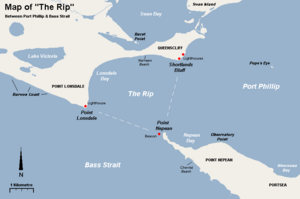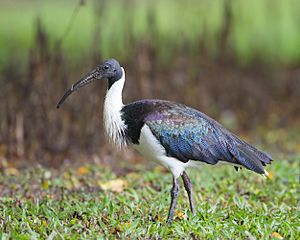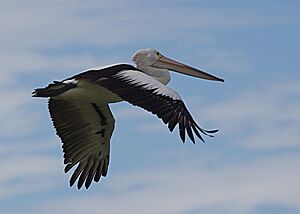Swan Bay and Port Phillip Bay Islands Important Bird Area facts for kids
The Swan Bay and Port Phillip Bay Islands Important Bird Area is a special group of places in Victoria, Australia. It's located at the eastern end of the Bellarine Peninsula and the southern part of Port Phillip. This area is super important for many birds, especially during winter. It's a key spot for orange-bellied parrots, which are very rare. It's also a vital home for waders (shorebirds) and seabirds.
Contents
What is the Swan Bay Area?
This special bird area includes several different types of places. Each one helps different kinds of birds and animals.
Key Locations in the Area
- Portarlington Sewage Treatment Works: This is a place where wastewater is cleaned. It creates wetlands that birds love.
- Swan Bay: This is a large, shallow bay, about 30 square kilometers. It has muddy areas that appear at low tide, which are perfect for birds to find food. It's surrounded by saltmarsh, a type of wetland with salty plants.
- Edwards Point: This is a 4-kilometer long sandspit, which is a narrow piece of land sticking out into the water. It has coastal forests, open grassy areas, and saltmarsh.
- Duck Island: A small island made of sand and saltmarsh.
- Swan Island: A larger sand island, about 140 hectares. It has coastal bushes and saltmarsh.
- Rabbit Island: Another small island covered in saltmarsh.
- Freshwater Lake: A small lake that sometimes dries up. It's surrounded by grassy areas.
- Lake Victoria: A shallow, salty lake that is 139 hectares big. It has large mudflats and is bordered by saltmarsh and sedges (grass-like plants).
- Mud Islands: A close group of three small, sandy islands. They cover about 50 hectares and have bushes, saltmarsh, and mudflats.
- Pope's Eye: A small island built by people. It has a wooden platform and a light to guide ships.
- South Channel Island: Another small island built by people.
- Wedge Light: A wooden platform with a navigation light nearby.
Protected Areas
Some parts of this bird area are extra protected. Swan Bay and Mud Islands are part of the Port Phillip Bay (Western Shoreline) and Bellarine Peninsula Ramsar Site. A Ramsar site is a wetland recognized as important worldwide. Swan Bay, Mud Islands, and Pope's Eye are also part of the Port Phillip Heads Marine National Park. This means the marine life and habitats there are protected.
Amazing Birds of the Area
This group of sites is called an Important Bird Area (IBA) by BirdLife International. This means it's one of the most important places in the world for birds.
Why is it Important for Birds?
- Rare Parrots: It's a key winter home for the critically endangered orange-bellied parrots. "Critically endangered" means there are very few left in the wild.
- Vulnerable Terns: It also supports vulnerable fairy terns. "Vulnerable" means they are at risk of becoming endangered.
- Large Bird Populations: Over 1% of the world's population of several bird species live here. These include blue-billed ducks, chestnut teals, Australian white and straw-necked ibises, red-necked stints, and silver gulls.
Bird Numbers and Colonies
The IBA regularly hosts more than 20,000 waterbirds. This includes between 4,000 and 15,000 waders (birds that wade in shallow water) and over 10,000 nesting seabirds.
- Storm Petrels: The biggest colonies of white-faced storm petrels in Victoria are found here. About 12,400 of these birds nest in burrows on Mud Islands and South Channel Island.
- Other Breeding Birds: Mud Islands is also a very important place for Australian pelicans, silver gulls, greater crested and Caspian terns, and ibises to breed.
- Gannets: Australasian gannets build their nests on structures made by people, like Pope's Eye and Wedge Light.
- Wader Movements: The waders often move between the different sites to find food and rest. However, they usually stay within this specific area and don't move to other parts of Port Phillip Bay.
Other Animals Living Here
The waters around this important bird area are also home to other amazing animals.
- Seals: You can find Australian fur seals and Australian sea lions in these marine waters.
- Dolphins: The special Burrunan dolphins also live here.
- Whales: Sometimes, large coastal whales like southern right whales and humpback whales enter Port Phillip Bay and can be seen near the reserve.






